The upgraded build quality of the Samsung Galaxy A54 5G is a nice selling point, offering the feel of a much more premium phone in a mid-range package, and the promises of upgraded performance and better battery life certainly sound tempting, but I’ll reserve my verdict for the full review in the coming weeks.
-
Premium materialsThe use of a glass rear in place of the plastic of last year’s A53 5G gives the A54 a more premium look and feel. -
Multi-day battery lifeSamsung claims that the 5000mAh battery can last two days on a single charge. -
Upgraded camera setupThough it looks like a downgrade on paper, the 50MP snapper boasts a larger sensor and bigger pixels for improved image quality.
Introduction
The Samsung Galaxy A54 5G looks to be a tempting upgrade for those on the hunt for a mid-range blower, boasting a refreshed design, premium materials and a promise of two-day battery life.
The upgraded materials mean Samsung’s £499 Galaxy A54 feels nice in the hand, and the upgraded 50MP camera with a larger sensor should provide a jump in quality compared to its predecessor, but is it enough to tempt consumers from popular mid-range alternatives like the Google Pixel 6a?
I spent a bit of time with the Galaxy A54 5G before its announcement, and here’s what I think so far.
Design and screen
- New Galaxy S23-like design
- Glass rear helps it feel premium
- 6.4-inch 120Hz AMOLED display
The Samsung Galaxy A54 5G has had quite the upgrade in the design department compared to its predecessor, the Galaxy A53 5G.
Most of said change is happening on the rear of the phone. The most immediately noticeable is that Samsung has ditched the contour camera housing present on last year’s model, instead opting for the same minimalistic design as the flagship S23 line.
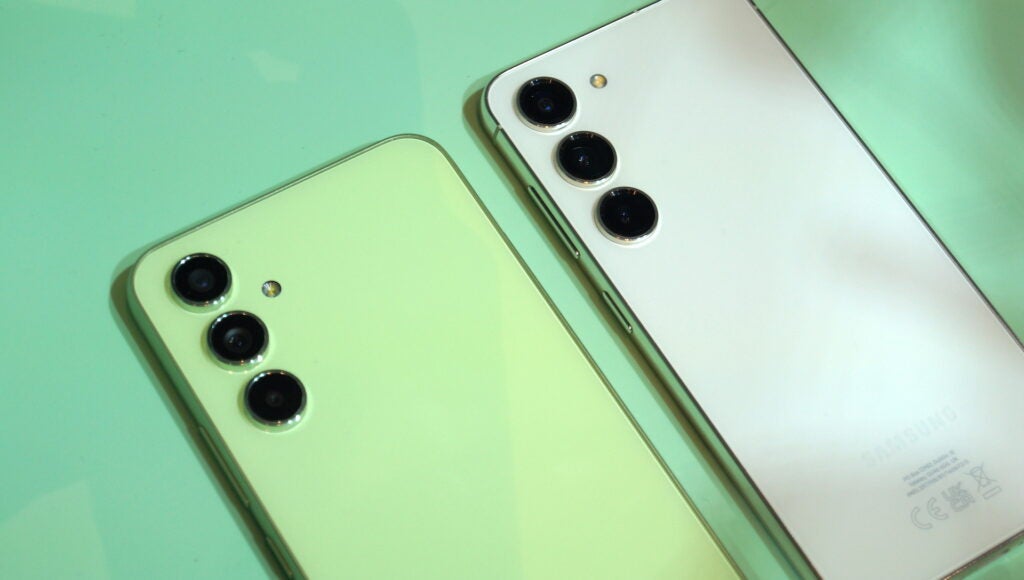
The simple trio of lenses on the rear is certainly one of the cleaner looks around, especially compared to rivals that use huge circular and rectangular camera housing. I personally think it’s a little too minimalistic, bordering on bland, but I’m sure there will be some that really appreciate the new look.
At least there are some stunning colour options available to jazz up the simplistic design, coming in particularly vibrant shades of Lime and Violet, along with a more muted Graphite and Silver. The lime green finish is a personal favourite of mine, with a vivid flash of colour that looks gorgeous in real life.
The other big upgrade for the Galaxy A54 is the material used; rather than going for ‘glasstic’ (that’s plastic to you and I) Samsung has given the A54 the premium treatment with a full glass rear.
It immediately makes the phone feel more premium in the hand, especially compared to the plastic Galaxy A34. It also adds a bit of heft, but not to the point where it feels substantial in the hand. At 202g it’s just heavy enough to feel premium without going to the extremes of the 240g iPhone 14 Pro Max.
It also sports the more rounded corners of the Galaxy S23 range, which helps the phone stand out from a sea of similar-looking mid-range alternatives, and IP67 dust and water resistance should protect it from most accidents.
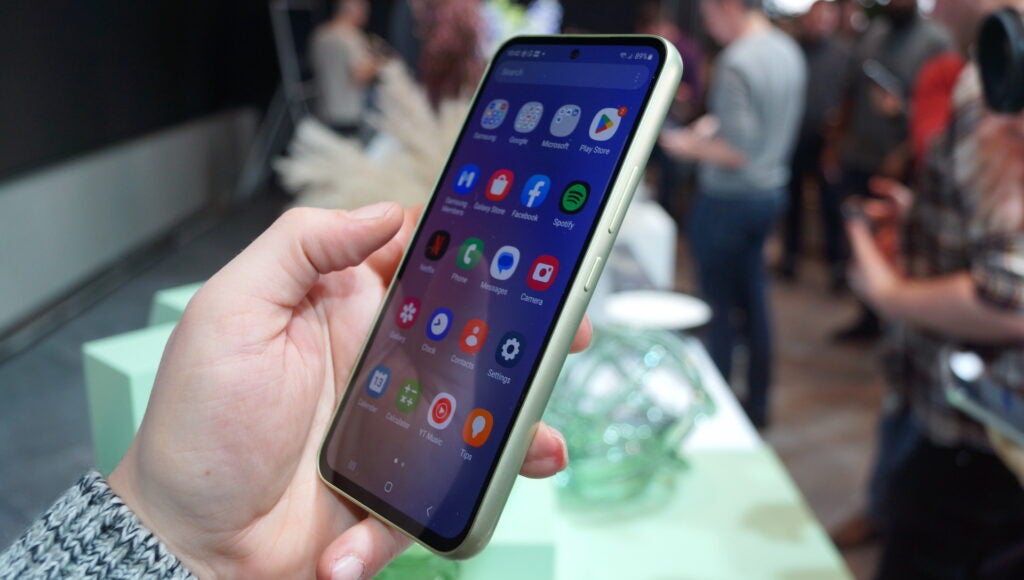
New design changes aside, it’s very much business as usual for the Galaxy A54, sporting a power button and volume controls on the right, a USB-C port on the bottom and a combined SIM and microSD card tray. The latter is a nice touch, allowing you to expand storage by up to 1TB if required – I wish it was a feature of the flagship S23 range too.
The 6.4-inch AMOLED panel sports an ‘Infinity O’ design that, to you and I, simply means it has a single hole-punch camera cutout in the middle of the display.
The combination of a FHD+ resolution and 120Hz refresh rate is nice, though it remains unchanged compared to last year’s A53. It would’ve been nice to see a jump to a higher refresh rate like the similarly priced 144Hz Motorola G200, but it’s arguably much of a muchness at that point. It felt buttery smooth when zipping around the UI, at the very least.
The display is dynamic, dropping between 60Hz and 120Hz depending on what you’re doing, though you can also force a 120Hz refresh rate at the expense of battery life.
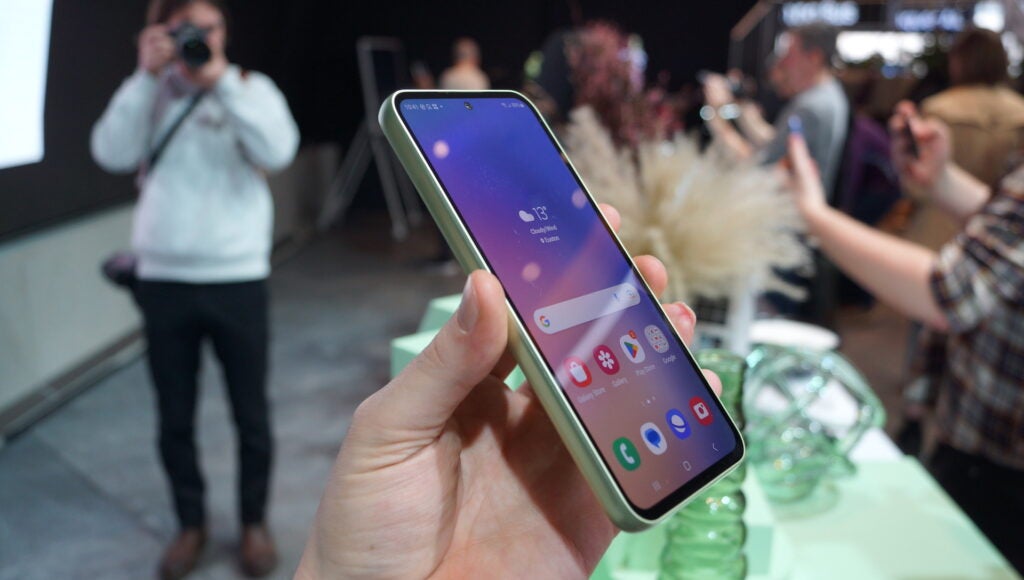
My first impressions of the display are largely positive; it’s big enough to comfortably watch YouTube videos and movies on Netflix, the colours are vibrant (if not a little too vibrant) and it looked detailed enough, even when compared to the WQHD+ panel on my daily phone.
The boosted 1000 nits brightness is also appreciated, which should make it easier to use in outdoor conditions, though that wasn’t something I could verify at an indoor hands-on event.
Camera
- All-new main 50MP camera
- Ultrawide and macro lenses remain unchanged
- 32MP selfie camera
The camera setup, at least where the main lens is concerned, looks like a downgrade – on paper, that is.
While the megapixel count has dropped from 64MP to 50MP with the Galaxy A54, it’s worth noting that it’s a completely new camera with a larger sensor and larger pixel size (0.8um to 1um, or 2um if you pixel-bin) that should capture more light and detail than its predecessor. An enhanced OIS is a nice touch too, even if it is exclusive to the main lens.
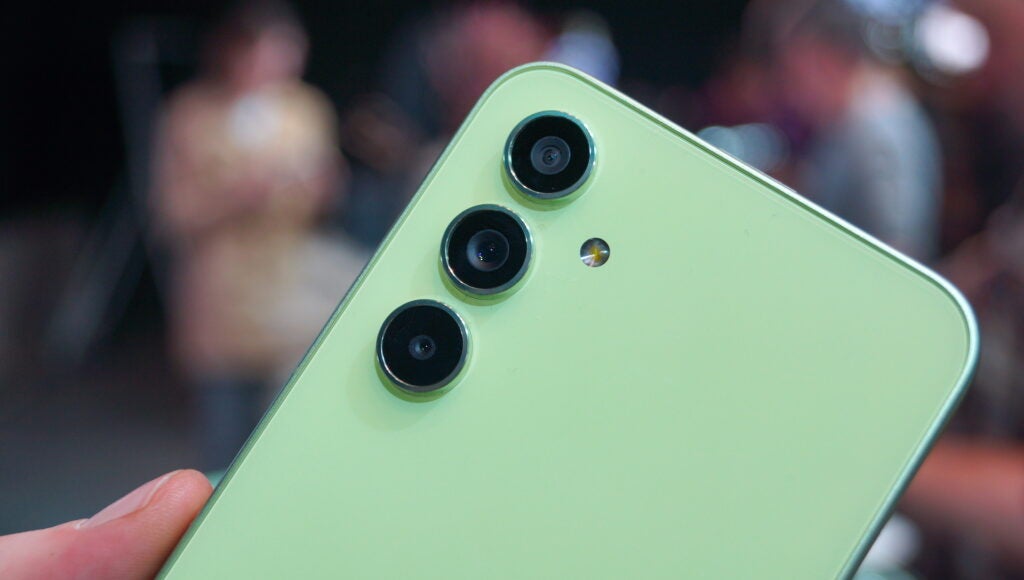
It’s not the only camera on the rear of the phone, but it is the most exciting, with the accompanying 12MP ultra-wide and 5MP macro lenses essentially remaining unchanged compared to last year’s mid-ranger.
Initial test shots did look promising when using pixel-binning tech to compress that 50MP image into a more usable 12MP image, though the hands-on area was exceptionally well-lit. It’ll be interesting to see how it fares in less-than-ideal situations, especially as light levels begin to drop. The phone does boast a dedicated Night Mode, though I’m not expecting S23 Ultra-level low-light shots.
Flip the phone over and you’ll find a 32MP hole-punch selfie camera embedded into the top of the display. Based on my limited testing it looks like it’ll suffice for selfie-taking and video calls with decent detail and light, but most of the camera work should be left to that 50MP rear camera.
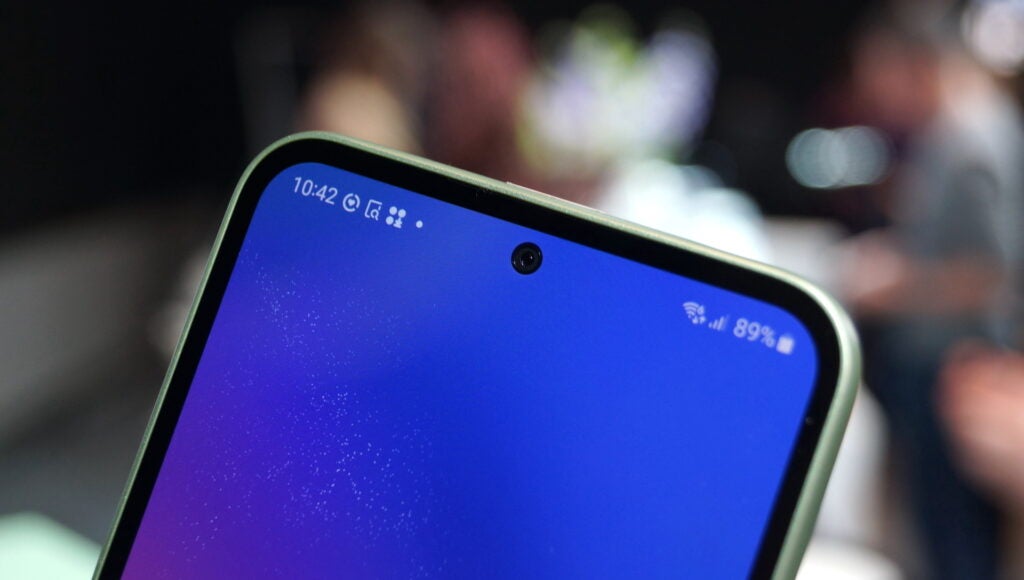
Performance
- Exynos 1380 chipset
- Samsung OneUI 5.1 based on Android 13
- 5000mAh battery said to deliver multi-day battery life
Unlike the Galaxy A34 which has ditched Samsung’s own processor for a MediaTek equivalent, Samsung’s Galaxy A54 sports an upgraded Exynos 1380 chipset – the latest one in the company’s roster having been revealed just a few weeks prior to the phone’s announcement.
That’s paired with 8GB of RAM regardless of whether you opt for the 128GB or 256GB variant, with the ability to use spare ROM as RAM in performance-hungry apps. You’ve also got the option to boost storage by up to 1TB with a microSD slot, something that’s missing from Samsung’s flagship range.
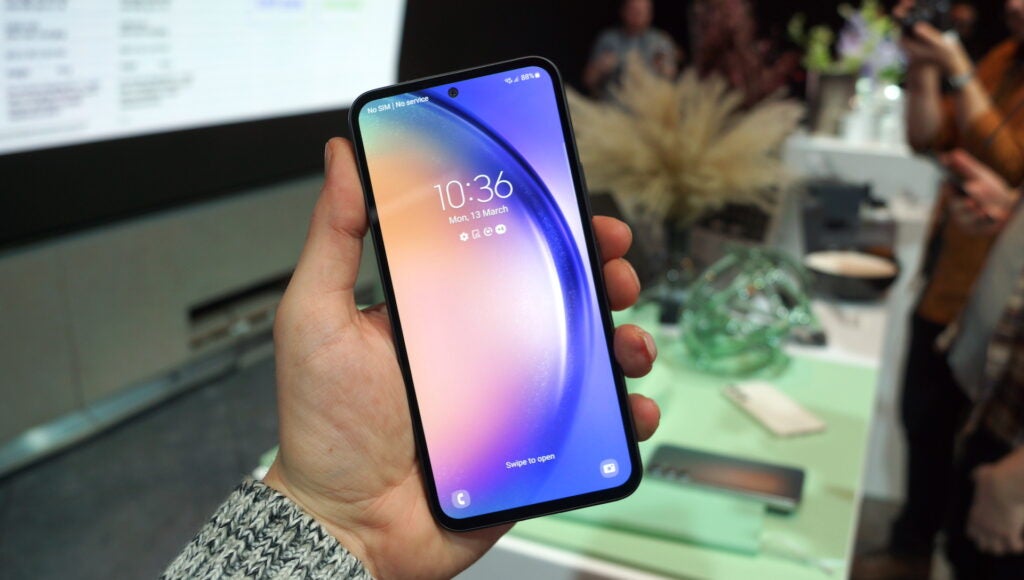
Samsung is promising big gains from this year’s hardware, with headline numbers including a 20% boost to CPU and a larger 26% gain in the GPU department. These sound promising, and I didn’t note any real lag or slow-down during my limited time with the phone, but the Exynos chipset hasn’t traditionally been the best at power efficiency so it’ll be interesting to see how the phone performs under pressure.
You’ll also get decent connectivity with the inclusion of 5G connectivity and the upgraded Wi-Fi 6.
When it comes to software, the phone ships with Samsung’s latest OneUI 5.1 based on Android 13. It’s very much the usual affair with Samsung’s signature UI design and heavy reliance on Samsung-branded apps, but with small new features like the ability to use certain Snapchat filters within the native Camera app thanks to a new partnership between the two companies.
Samsung’s going all-in on battery life with this year’s A series, with both the Galaxy A54 and its cheaper A34 sibling both sporting a large 5,000mAh battery – the same as the top-end S23 Ultra, and larger than both the S23 and S23 Plus.
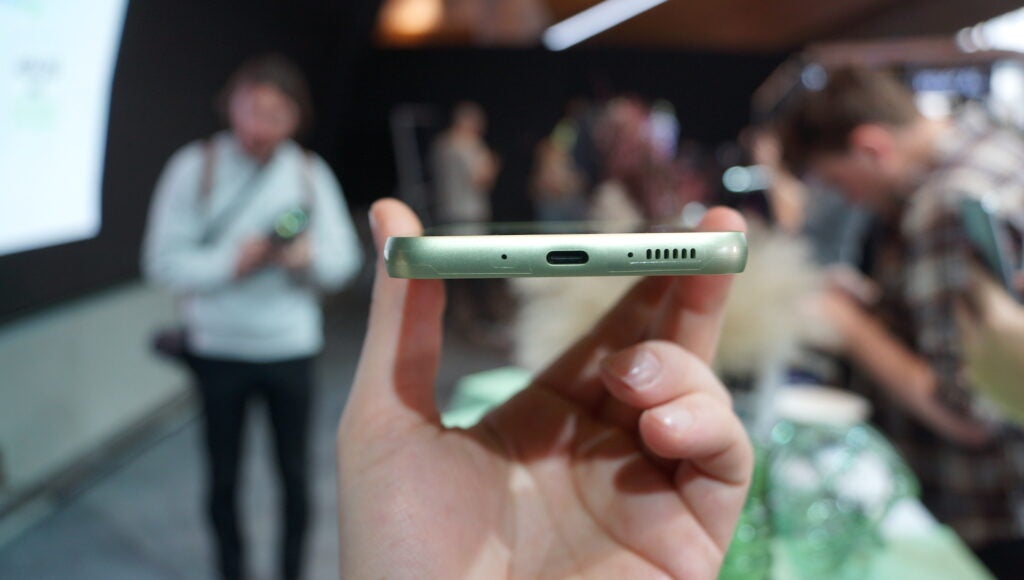
The company claims that this should be enough to last around 2 days without a charge, though I imagine that’ll vary widely depending on what exactly it is you’re doing. Either way, it’ll be an interesting one to benchmark.
Sadly charging isn’t quite up there, especially when powering such a large capacity battery, capping out at 25W. For context, the S23 Ultra took 91 minutes to achieve a full charge in tests, and that’s with a faster 45W charger, so I’d expect something closer to the two-hour mark for the A54 – but again, I shall confirm once I get a sample to review.
Early Thoughts
The upgraded build quality of the Samsung Galaxy A54 5G is a nice selling point, offering the feel of a much more premium phone in a mid-range package, and the promises of upgraded performance and better battery life certainly sound tempting, but I’ll reserve my verdict for the full review in the coming weeks.
















